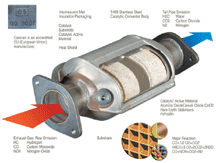Ethanol and Other Problems
Changes in in Gasoline’s and the Problems it is Causing Fuels
Due to the large number of recent changes to fuel, numerous problems with gasoline powered vehicles have developed. These problems are not always immediately identified as fuel problems, and therefore technicians are spending a lot of time and money on symptoms, rather than root causes.
Most technicians will tell you that they have seen a dramatic increase in the number of complaints of performance, poor fuel economy, or Check Engine light illumination due to the failure of the exhaust related emissions items (EGR, Oxygen Sensors, Catalytic Converters, etc.) in the last 2 years. Ask them the root cause and you will hear many theories.
In order to properly understand what is happening a little history review is helpful. In the late 1980?s emissions standards had become more stringent making fuel injection a necessity. These vehicles burned cleaner and ran better than Carburetor equipped vehicles ever could.
Drive-ability concerns began to develop after a short period of time (7500 miles or so) in the form of starting and stalling when cold, rough running, and stumbling on acceleration. These were caused by the accumulation of soft carbon deposits on the back side of the intake valves and dirt formation on the injector.
The higher operating temperatures and tighter clearances combined with the quality of fuel were the main contributing factors to these problems. Repairs ranged from cleaning or replacing injectors to removing intake manifolds and blasting off the carbon accumulation on the valves with Walnut Shells.
In the early 1990?s the Federal Government established requirements for fuel additives to reduce the occurrence of these problems. All fuel sold in our country had a minimum amount of cleaner whether the fuel companies advertised it or not. One of the main additives was MTBE. It was very effective at keeping injectors clean and carbon growth to a minimum. In the mid 1990?s vehicles were required to adhere to more stringent emissions standards and OBDII technology was universally adopted on all vehicles sold in this country. More precise control of all variables affecting emissions was needed to meet the new standards and the Power Train Control Unit (PCM) had more input sensors and more control of outputs such as fuel trim and ignition timing. The amount of cleaner in the fuel was adequate in most applications to stay within emissions and maintain acceptable levels of drivability. Thing remained fairly constant until the price of crude oil began to rise dramatically shortly after 2000.
The Federal Government was keeping a close watch on the price of gasoline in this country due to its impact on the economy. When the price of fuel rose above $3 per gallon the Government approached fuel manufactures for an idea of where things were heading. With the threat of $5 per gallon fuel, the regulations for the required amount of cleaner in fuel was lowered substantially. This did keep the price down, but drivability concerns began to slowly return. Decrease fuel economy, poor performance, and increase EGR system concerns were the first indicators of problems.
The root cause was the increase accumulation of deposits in the combustion chamber causing hard carbon to form. The OBDII system reacts to detonation (spark knock) faster than the ear can detect it. It electronically retards the timing until the detonation stops. This retarding of the ignition timing robs power and economy and creates more emissions in the exhaust stream. Most vehicles began to show symptoms after 30,000 to 40,000 miles.
Shortly after this first change, MTBE was found to be a cancer causing agent that easily finds its way in to ground water and contaminates it for upwards of 600 years. It was ordered out of fuel, yet cleaners were still needed. The most common replacement currently used is Ethanol.
Ethanol does have some cleaning qualities; however the negative side effects are staggering. It is a very strong product that attacks plastic. As most fuel systems have moved to plastic or epoxy coated parts, this has caused severe problems already. Fuel filters are becoming clogged, and the dissolved plastic forms deposits anywhere it can find a heat source from the fuel pump, to the injectors. Once sprayed from the injectors, the deposits cause hard and soft carbon to form at an alarming rate. Most vehicles have noticeable concerns after as few as 15,000 miles! The trouble is not isolated to the previous areas of concern, but instead has more far reaching detrimental effects. Severe deposit formation causes excessive ignition timing retardation.
Oil contamination due to blow by (a normal condition) is compounded with unburned or partially burned Ethanol causing engine oil to emit phosphorous vapors into the PCV system which are in turn pulled into the intake system and burned. These Burned phosphorous vapors coat the sensing surfaces of the Oxygen sensors and the reaction bed of the Catalytic Converter causing them to malfunction further affecting drivability and illuminating Check Engine Lamps.
Enertech Labs, Inc. offers solutions to these and many other problems through products, service equipment, and training.


